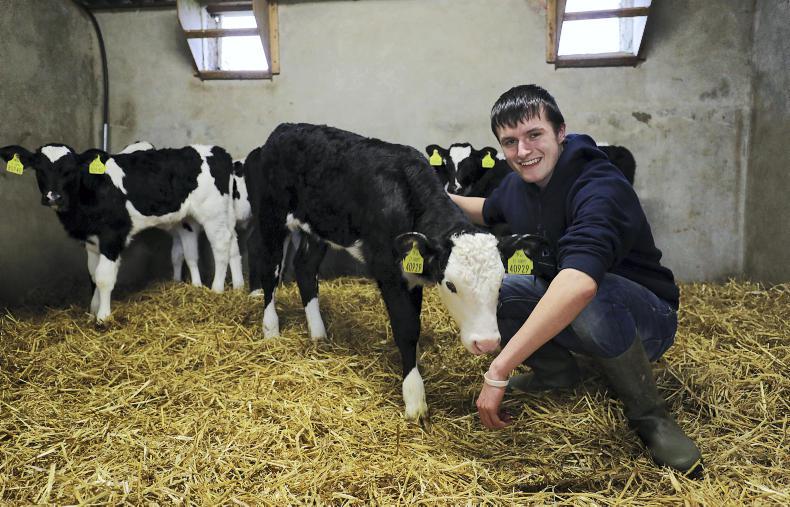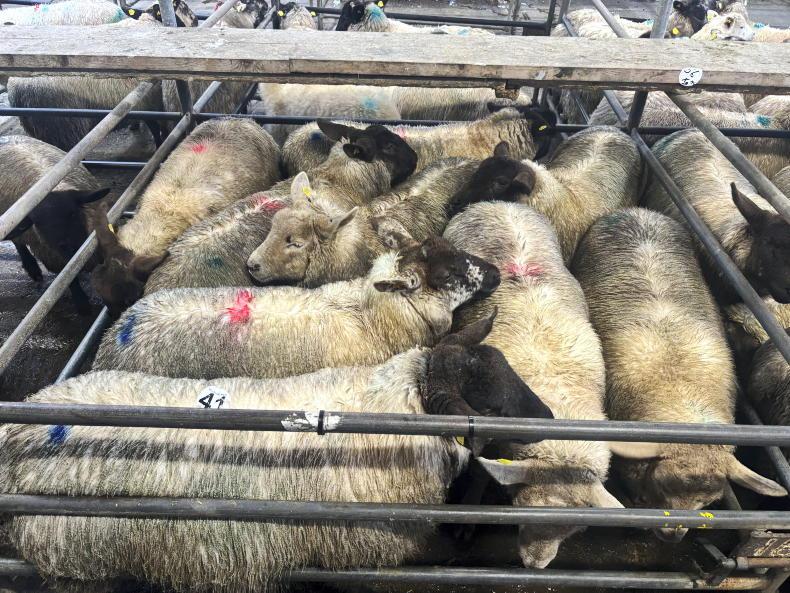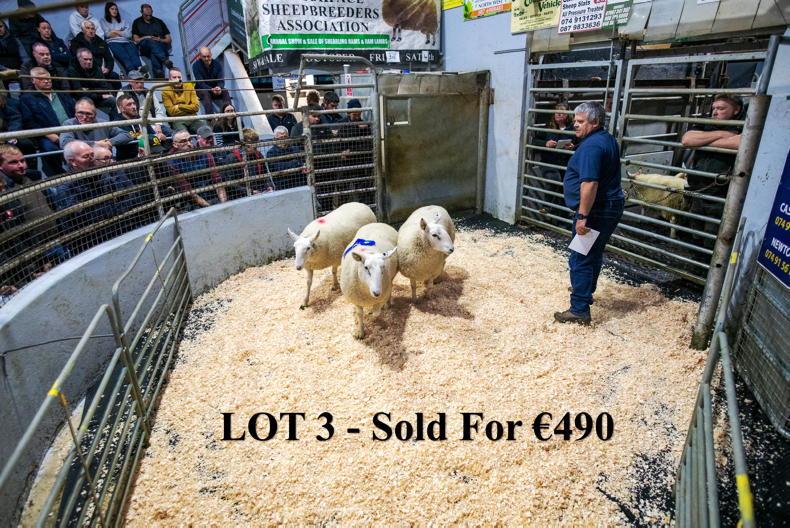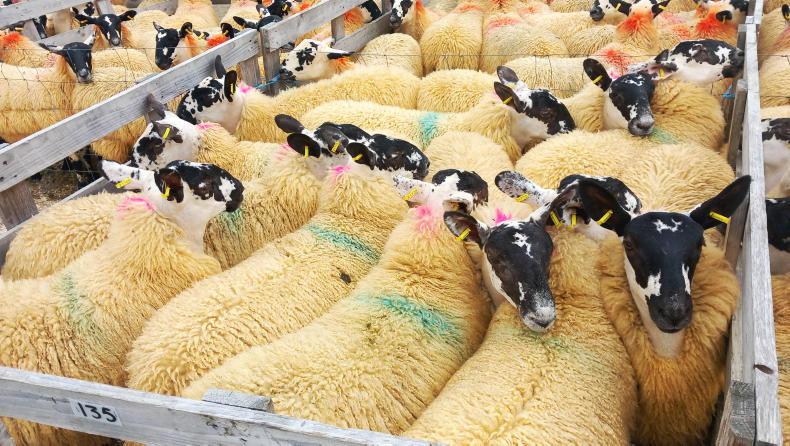Store lamb sales are in full swing across the country. Knowing what system to apply and the potential of the lambs you are purchasing is important decision making factor to know from the outset. Here we look at the latest advice on finishing store lambs on autumn pasture and all-concentrate intensive finishing diets, presented at a Teagasc open day in Athenry.
The role of grass in the diet of finishing lambs will diminish in line with a reduction in grass quality. Farmers attending the event were told that the typical daily liveweight gain of lambs during November could be in the region of 80g/day to 110g/day, dropping to 50g during December and January.
This is provided lambs have access to good-quality grass and reasonably dry underfoot conditions to give rise to favourable grass utilisation.
If utilisation is poor and grass dry matter is low, lambs will do well to maintain weight, with low-level concentrate supplementation (300g to 500g) required to hit these weights.
Light lambs
While the performance figures described above are low, they may fit into a system where light lambs are being carried over the winter and develop a frame before being intensively finished.
This is an approach taken by many specialised finishers in recent years to take advantage of rising farmgate returns in springtime.
It has also been an unavoidable production system adopted by others in the absence of traditional light lamb markets, with producers having no option but to try to bring light hill lambs close to French lamb weights and at least in excess of 14kg to 15kg carcase weight.
Finishing blueprints
Numerous studies have been carried out in the last four years in Athenry to identify suitable finishing blueprints for purebred and crossbred hill lambs with varying starting weights.
These blueprints were outlined by sheep enterprise leader Michael Diskin, sheep specialist Frank Campion and PhD student with the trial Noel Claffey.
The advice given, irrespective of the type of lamb, was to exhaust the potential of grazed grass where possible. This is not giving licence to retain lambs outdoors at the expense of grass supplies for competing ewes, but rather is aimed at optimum management and best use of autumn and winter grass supplies.
As mentioned above, this will bring lambs to a heavier liveweight at the start of the intensive finishing period, which will help hit target carcase weights and reduce the length of the finishing period.
Study 1: finishing light lambs
Table 1 details the results of a trial undertaken with light- and medium-weight Scottish Blackface and Texel-cross-Scottish Blackface lambs at two starting weights of about 25kg and 30kg.
Performance and food conversion efficiency was higher, as expected, for the Texel-cross lambs.
However, satisfactory levels of performance was still achieved for the Scotch lambs, with over 96% hitting target French carcase weights in excess of 16kg.
Starting lambs on an intensive finishing diet at a lighter weight than 25kg is probably not feasible, as lambs will end up going overfat before reaching the target liveweight/carcase weight for slaughter.
This is a consideration that needs to be taken into account with lambs weighed and drafted on a weekly basis as they approach slaughter weight.
Study 2: starting at heavier weights
A second study was undertaken to push the boundaries on what could be achieved with lambs purchased earlier in the season. Again, Scottish Blackface and Texel-cross-Scottish Blackface lambs were used, with the only difference to Study 1 being an earlier purchase date of the end of July, resulting in higher liveweight gain from grass. Performance of rams versus castrates was also compared as shown in Table 2.
The average daily gain was higher than the previous study, with the Texel-cross lambs in particular taking advantage of having developed a large frame and gaining on average from 315g daily to 364g daily, while the Scottish Blackface gained 218g to 255g, with ram lambs performing best in both breed types.
Lambs also consumed significantly more, but gave a good return on investment with the performance levels attained. Ram lambs gained more during the finishing phase, but much of the higher gain was cancelled out by castrates having a higher kill-out.
The importance of regular weighing and drafting really came under the spotlight with the Texel-cross lambs quickly finishing into heavy weights, helped by a combination of high levels of daily liveweight gain and a high kill-out. Castrated lambs were also more at risk of going over-fat with the greatest risk with the Scottish Blackface lambs.
Study 3: Hill breed comparison
Studies have been carried out in Athenry comparing the performance of Cheviot lambs with three different Scottish Blackface strains: Connemara-Mayo, Lanark and Perth. All lambs were castrated, started on the study at a similar liveweight of 29kg and retained on the intensive finishing diet for 62 days.
The Cheviot lambs recorded the best daily liveweight gain, with 24g higher daily performance, and the highest kill-out of 45% returning a favourable carcase weight of 19.2kg, significantly above the three Scottish Blackface breed strains.
The Lanark and Perth lambs had slightly higher performance than the Mayo-Connemara lambs, but a higher kill-out percent for these meant they returned an 18.3kg carcase compared with 17.8kg and 17.7kg for Lanark and Perth lambs respectively.
However, Connemara-Mayo lambs tended to be more prone to going overfat and had a lower conformation score, which was similar for the other three groups.
Top finishing tips for store lambs
Health advice
There is no room for passengers. Unhealthy lambs do not perform and significantly increase finishing costs. Address health concerns first before transferring lambs on to an intensive finishing diet. Worms, liver fluke, lameness and clostridial disease vaccination are the main factors to consider in a health programme. Regular foot bathing every two to three weeks is recommended to prevent problems establishing. Beware when administering health treatments to take account of withdrawal dates and the expected date lambs will be fit for slaughter.
Introducing meal feeding
Train lambs to eat first if possible. Where doubt exists that some lambs may not be eating, Teagasc advises to start from the same base and introduce concentrates gradually, starting at a low level of 100g to 200g daily.Watch lambs closely. With hill lambs, there will inevitably be some shy eaters that may need to be removed into their own pen for special attention. Build up to ad-lib meals, increasing by 200g every two or three days until ad-lib. This will take a week to two weeks to achieve depending on the starting point.
Feed space and trough management
Remember feeding space is critical and an allocation of 300mm to 400mm will need to be given to horned lambs until they become accustomed to an ad-lib diet.
Trough management is critical – avoid offering too much feed, resulting in feed going stale or too little that lambs become hungry and the risk of acidosis is reintroduced.
Roughage and fibre content
Offer lambs access to a small quantity of roughage (hay, silage, straw) at the outset. This can be continued, but reduce it to a small level as offering too high a quantity will only serve to displace meal intake. Roughage can in theory be cut out as long as the crude fibre content of the concentrate offered is over 7%. Lambs on trial in Athenry are offered a small quantity of silage, with about half the 400g fresh weight offered per lamb generally consumed.
Access to water
Water is crucial at all times. Troughs should be checked regularly to ensure water is clean and flowing OK. Remember to account for small lambs that may not easily reach the water bowl. Placing a couple of blocks in front of the drinker will aid lambs in reaching the required height to eat.
Diet formulation
Focus on high-energy ingredients, avoiding too high of a percentage of finely ground ingredients or very high starch diets that will break down fast. Whole cereals work well in a ration in slowing down digestion.
There are advantages and disadvantages of pelleted versus coarse rations. Birds can be an issue with coarse rations, while lambs can sometimes segregate ingredients and focus on the most palatable ones.
Don’t forget to add minerals and vitamins. Well-grown lambs only need a protein content of 11% to 12%, growing lambs 13% to 14% with very light lambs (under 30kg) benefitting from a protein content up to 16%.
Teagasc advises to include ammonium chloride at 0.5% for male lambs on feed long-term to prevent urinary calculi. Some concentrates include a higher content of salt to promote greater water intake, which in theory will prevent urinary calculi developing. This was highlighted as being risky if lambs are not drinking sufficiently for any reason, with the typical cost of €5/t for ammonium chloride seen as very worthwhile for peace of mind.
Intake, performance and drafting
There is huge variation between intake and performance, with intake ranging from 0.5kg concentrates to 1.8kg to 2kg at the top end. This influences performance, with daily liveweight gain as low as 80g, rising to 400g to 500g in the highest-performing lambs. The average is 200g to 250g for Scotch Blackface and Cheviot and 270g to 350g for crossbred lambs. Lambs starting the intensive finishing period at heavier weights need to be weighed regularly in order to draft at paid weight limits, while fat cover is also an important factor that needs to be monitored, with wether lambs most prone to going overfat.
Shorn v unshorn
Results from trials undertaken show no effect from shearing lambs on average daily gain, feed intake conversion efficiency or final carcase weight.
Kill-out was 1.2% higher in shorn lambs by merit of lower weight with no wool.If shearing for management, it is advisable to do earlier in the season to get a benefit from lower risk of flystrike and lambs not becoming caught in briars, etc.
It may have a role in keeping lambs cleaner where lambs are being finished outside on catch or root crops.
Other concerns
Horned lambs seem to be more prone to injury stemming from getting horns trapped in gates, slats, etc.
Teagasc also advises to monitor horn growth on lambs as there will be a significant number that may need to have the tips of their horns cut to stop them growing into lambs eyes/head.












SHARING OPTIONS